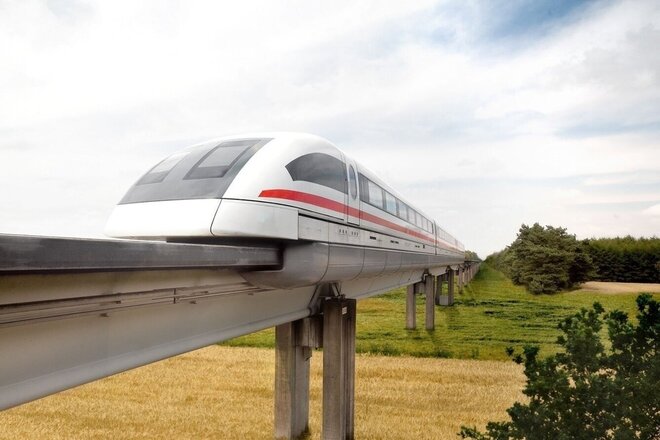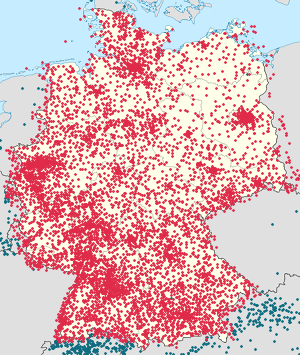61,926 署名
コレクション終了
請願書の宛先: Deutscher Bundestag Petitionsausschuss
The Transrapid is a magnetic levitation railway that was developed for use in long-distance transport. It is capable of significantly improving long-distance transport in Germany. The Transrapid is not only convincing due to its technical advantages - the gain in terms of transport policy would be enormous, especially at a time when Deutsche Bahn's rail network is heavily utilised, with every second long-distance train running late at times and thousands of cancellations every year. The Transrapid was developed to overcome the technical hurdles of the conventional railway.
Speed. The Transrapid is designed for speeds of 400 - 500 km/h.
Lower energy requirement. As there is no rolling resistance, the energy requirement of the Transrapid is significantly lower than that of the ICE. As the drive components are installed on the track side, the vehicle is significantly lighter than an ICE. With a comparable number of seats, a Transrapid weighs almost half as much as an ICE. At 350 km/h, a TR08 consumes 40% less energy per seat than an ICE 3. At 300 km/h, the figure is 30%.
Reliable & punctual. By operating on a self-sufficient infrastructure and eliminating many mechanical wear parts, the Transrapid is reliable and punctual. In Shanghai, 99.96% availability of the system is achieved. Meanwhile, only 52% of ICEs managed to arrive on time in Nov. 2023.
Flexible routing. The Transrapid can easily cope with gradients of up to 10%, whereas the ICE reaches its limits at 3-4%. This means that fewer tunnels are required. In addition, its land consumption is less than that of the ICE, both elevated and at ground level. The elevated construction method is easy to route and can be built over existing infrastructure (rivers, roads, railway tracks). Landscapes are not cut through and farmers can continue to cultivate their fields. There is no need for railway crossings and wildlife movement is not affected.
Relief. A Transrapid line relieves other modes of transport by taking over capacity. It is to be expected that many car drivers, long-distance passengers and air travellers will switch to the Transrapid insofar as it competes with other modes of transport. As a result, there will be fewer cars on the roads, fewer planes in the air and fewer trains on the rails, which will relieve the currently overloaded German railway network and free up more capacity for local and freight transport.
Environmentally friendly. The drastically reduced wear (cf. ICE system) means that components last a very long time. The Transrapid track can be used for 80 - 100 years without major repairs. No wheels on the vehicle need to be inspected and replaced: Because there are none. In addition, the Transrapid is significantly quieter than conventional high-speed trains at the same speed. Measurements have shown that at 300 km/h, the Transrapid is only half as loud as a TGV. The Transrapid whizzes past after just three seconds. The sound frequencies that are produced as the train passes by are also much more pleasant to the human ear. Thanks to its fully electric drive and levitation system, it can make a significant contribution to replacing intra-European air traffic in a climate-neutral way (depending on the energy source).
Economical. The Transrapid is an economical transport system due to its low-maintenance operation, its high energy efficiency, the long service life of the infrastructure and its investment costs. Despite the aforementioned advantages of high speed and long service life, the investment costs of the Transrapid are roughly the same as those of the ICE.
Example in comparison (Source: SIEMENS, 2001 The maintenance costs for the entire system are almost 70% lower than for the ICE):
- 1 double kilometre Transrapid route Hamburg-Berlin: EUR 17 million per km.
- 1 double kilometre of ICE tracks Nuremberg-Ingolstadt: EUR 30.9 million per km.
- 1 double kilometre of TGV tracks Seoul-Pusan: EUR 42.2 million per km.
Wide range of applications. The Transrapid accelerates and brakes significantly faster than an ICE. While it only needs 4.3 km (98 s) to reach 300 km/h, an ICE needs 17.9 km (324 s). While it only needs 3.6 km (87 s) to brake from 300 - 0 km/h, the ICE needs 6.9 km (168 s). This also makes the Transrapid suitable for route projects with many intermediate stops, whereby the time loss remains manageable due to the high acceleration and braking power of the Transrapid. It can be operated on a Europe-wide long-distance transport level as well as a connection for many nearby cities (see the Metrorapid project planned for 2002).
What are we waiting for? The advantages are obvious - which is why we are asking you to sign this petition. You can find more information about our motives at magnetbahn.org.
理由
The Transrapid has the potential to relieve the heavily congested rail network, particularly in long-distance transport. With maximum speeds of over 400 km/h, travelling on long-distance services will become pleasant again - in stark contrast to the current unpunctuality of ICEs and the thousands of train cancellations every year on long-distance services alone. In this case, Germany urgently needs to invest in new infrastructure to improve the state of the railway. Why don't we rely on this environmentally friendly means of transport - at least where it really makes sense - which can relieve the rail network and short-haul air traffic in a climate-neutral way (depending on the energy mix)? And this despite the fact that the investment costs, as already described, are no higher than for the ICE?
請願に関する情報
請願開始:
2024/03/10
コレクション終了:
2025/03/07
地域:
Deutschland
カテゴリ:
渋滞




